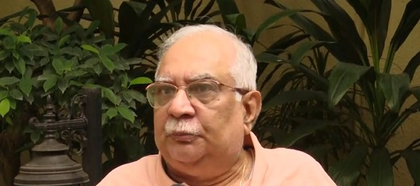Good sign amid global headwinds: Delhi economists hail India’s GDP growth of 7.8 pc in Q1 FY26
By IANS | Updated: August 30, 2025 17:50 IST2025-08-30T17:46:25+5:302025-08-30T17:50:13+5:30
New Delhi, Aug 30 Delhi-based economists on Saturday hailed India’s robust GDP growth of 7.8 per cent in ...

Good sign amid global headwinds: Delhi economists hail India’s GDP growth of 7.8 pc in Q1 FY26
New Delhi, Aug 30 Delhi-based economists on Saturday hailed India’s robust GDP growth of 7.8 per cent in the first quarter of the financial year 2025-26, describing it as a stronger-than-expected performance driven by manufacturing, construction, and services. They called it a “good sign” amid global economic headwinds.
Economist Aakash Jindal told IANS, “India’s economy has grown at a faster-than-expected rate of 7.8 per cent in the June quarter. When compared to other major economies like Germany, the US, Japan, and the UK, which are facing negative or sluggish growth, India stands out with its capability for rapid expansion. Despite challenges such as COVID-19 in the past and now US tariffs, India has demonstrated resilience. Over the last five years, while global economies slowed, India has continued to move forward strongly.”
Manoranjan Sharma, Chief Economist at Canara Bank also reacted and said, “This is a very good number, especially at a time when the world is grappling with issues like the Ukraine-Russia war, US tariffs, and Middle East uncertainties. We were expecting around 6.5 per cent growth, but the outcome has surpassed estimates. This will strengthen India’s global position.”
He further highlighted the role of agriculture, noting a “remarkable increment” in the sector.
“There has been no major immediate impact of US tariffs. However, they may affect the economy in coming months. If we focus on promoting Swadeshi products, it can further boost growth. Overall, this is a very positive and encouraging sign for India’s economy,” Sharma added.
India's gross domestic product (GDP) is projected to grow 6.5 per cent this fiscal with downside risks from the US tariff hikes, according to Crisil.
India’s real GDP growth accelerated to 7.8 per cent year-on-year in the first quarter of this fiscal, compared to 7.4 in the fourth quarter of last fiscal.
“Growth on the supply side rebounded 7.6 per cent, driven by the services sector, with a statistical low-base effect coming into play as well. The manufacturing sector gained from lower input costs amid rising domestic demand and advanced export shipments,” said Dipti Deshpande, Principal Economist, Crisil.
Consumer demand — buoyed by healthy rural incomes, lower inflation and interest rates and income tax relief — is expected to remain robust in the coming quarters and support overall GDP growth, while healthy government investment spending should continue to provide a buffer.
On the demand side, the main driver, household consumption, rose to 7 per cent from 6 per cent. Government spending also accelerated, with government consumption expenditure and investment seeing improvement.
Increased front-loading of capital expenditure by the states and the Centre (combined at 27.8 per cent on-year during the quarter) played a major role in supporting growth. A ramp-up in exports prior to the imposition of the US tariff hikes also helped.
“However, India’s export advantage would fade in the coming quarters because of the 50 per cent tariff hikes imposed by the US. Besides, a broader global slowdown triggered by the tariff actions could further dampen external demand,” said Deshpande.
Additionally, higher US tariffs and elevated uncertainty could impact domestic private investments this fiscal. The tariffs, a global trade slowdown and geopolitical uncertainties are expected to have a non-uniform impact on the Indian economy.
However, in the absence of a trade deal between India and the US, a few sectors will have to brace for a bigger impact, given the US tariffs.
Specifically, the micro, small and medium enterprises (MSME) sector, which accounts for 45 per cent of India’s total exports, faces formidable challenges, said Crisil.
Disclaimer: This post has been auto-published from an agency feed without any modifications to the text and has not been reviewed by an editor
Open in app